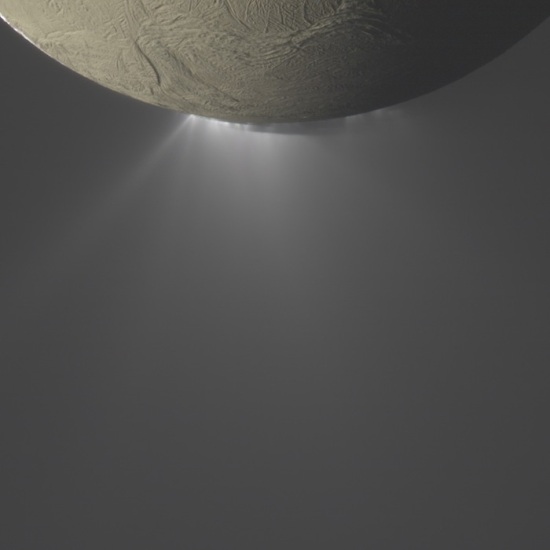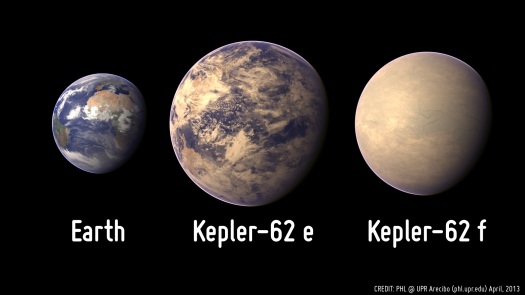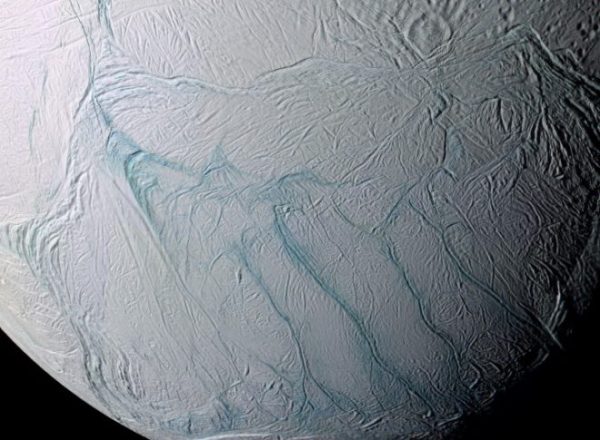
As if the prospect of billions of potentially habitable exoplanets wasn’t enough to get people excited, what about all those watery exo-moons too?
The question arises as the Cassini mission makes its final pass near the now famous geysers at the south pole of the moon Enceladus ,scheduled for Saturday. The plumes are currently in darkness and so it’s a perfect time to tease out a particularly compelling aspect of the Enceladus story: how hot is the inside of the mini-moon. Earlier measurements of the water ice spray took place when the sun was on that southern pole, so this will be the first time Cassini can measure precisely how much of the already detected heat comes from the moon’s interior.
The expectation is that much of the heat does indeed come from inside, warmed substantially by tidal forces and perhaps hydrothermal vents that together serve to keep liquid a subsurface ocean all around the moon. As a result, the evolving scientific view is that tiny Enceladus, one of 63 moons of Saturn, just may have the ingredients and characteristics that put it into an improbable habitable zone.
“Step by step, we’re learning about an environment that seemed impossible not long ago,” said Cassini Mission Scientist Linda Spilker. “We know that Enceladus has some rocky core, and that it touches the liquid water. We also know that some of the compounds identified in the geysers can only be formed when rock is in contact with hot water, and that must be happening at the bottom of the moon’s ocean. All the pieces are coming together to tell us that the moon has an ocean that might be able to support life.”

That a moon might have habitable conditions is not a new idea: science fiction great Arthur C. Clarke (as well as many scientists and now members of Congress) have pressed for a mission to Jupiter’s moon Europa because its internal ocean has been identified as similarly promising.
But what is so compelling about Enceladus is that its potential habitability pretty much came out of nowhere. While Europa is the sixth largest moon in the solar system, Enceladus is but 370 miles in diameter. It is covered in ice, but in 2004 its four parallel “tiger stripe” fractures were discovered, leading to the conclusion that some kind of volcanic action was taken place beneath them. Spilker was a scientist with the Voyager mission that passed by Saturn in 1980-81 and said that Enceladus was then in relative darkness and made little impression on the team. “We definitely missed the tiger stripes,” she said.
The plumes emerge from the south pole region, not far from the tiger stripe fractures, and appear to come from near-surface pockets of liquid water. (The oceans of Europa are not nearly as accessible, lying 6 to 20 miles below the icy surface.) Making Enceladus even more interesting, the 70 geysers spit out organic chemicals known as the building blocks of life along with its water ice.

So Enceladus (and perhaps Europa, too) provide a kind of emerging “proof of concept” that ice-covered water worlds can and do exist elsewhere. (Jupiter’s giant moons Ganymede and Callisto also have massive ocean, but far below their surfaces and sandwiched between layers of ice.) In fact, subterranean oceans may be common because, in recent years, scientists have come to understand that water — especially in its vapor and ice stages — is ubiquitous in the solar system, the galaxy and the universe. Comets, which are generally half water ice and half rock, are one of numerous delivery systems.
And we already have, of course, one good example of what would generally be considered a waterworld without the ice covering — Earth. But that’s not all, even without leaving our solar system. We look at planets such as Mars and Venus and now see desiccated landscapes. Yet it is broadly accepted that Mars once was quite wet on the surface, based on findings from the Curiosity mission and years of satellites imaging, and some have speculated that Venus might once have been wet as well.
So are there many waterworlds or aquaworlds with surface liquid water out there?
“It would be fair to say there is a consensus view that exoplanets and moons with lots of water are all over the place,” said Joel Green, an exoplanet scientist with the Space Telescope Science Institute. “The known presence of so much H2O makes that non-controversial.”

What is indeed controversial is whether any waterworlds, or even potential waterworlds, have been detected. There actually has been wide coverage of waterworld discoveries far, far away, and even some declared confirmations. But so far at least, those confirmations have not lasted. As early as 2004, the Hubble Space Telescope identified the signature of water vapor in the atmosphere of an exoplanet, and similar detections have followed. But that information and more that scientists have collected and modeled about H2O on exoplanets has never been sufficient to make a confirmation stick.
“It’s a very challenging detection to make, and many don’t think we haven’t gotten there yet,” Green said. Especially challenging is the detection of liquid water, since it does not show up using optical, infrared, ultraviolet or any other kind of light, and so can’t be identified with a spectroscope. It’s presence can only be inferred based on other conditions. Water vapor and water ice are, however, detectable via spectroscope.
But waterworld theories abound. For instance, scientists know that Neptune and Uranus in the outer part of our solar system consist of vast amounts of water ice, and they also know that planets tend to change orbits and sometimes migrate closer to their suns. Marc Kurchner of NASA’s Goddard Space Flight Center has proposed that if similar planets were to migrate inward in different solar systems, the result could be a very wet planet, with oceans hundreds of miles deep.
There is a general tendency to associate the presence of water with the presence of life, and the ubiquity of water in the galaxies with the likelihood of finding life. But while life is found everywhere that water exists on Earth, that does not at all mean that the discovery of water elsewhere means life will be present, too.
All it means is that one of many prerequisites for life (as we know it) will have been met. But as Enceladus shows, when water is present, all kinds of interesting things start of happen.


It is a bit ironic to call a planet (Earth) that has 0.05 % water by mass for a water world. If our system is anything to go by, the ice moons is usually where most water is. (As Europa alone has twice the ocean mass of Earth.)
But we will have to take our habitability where we find it.
Some pertinent results on water:
– “Missing Water Mystery Solved in Comprehensive Survey of Exoplanets … a correlation between hazy or cloudy atmospheres and faint water detection.” [ http://www.astrobio.net/topic/deep-space/cosmic-evolution/missing-water-mystery-solved-in-comprehensive-survey-of-exoplanets/#sthash.ZCg1X5Ks.dpuf ]
– “Alien Oceans’ Glint Could Reveal Habitable Water Worlds … The bright glint of alien oceans may be visible from afar, allowing astronomers to flag potentially habitable exoplanets.” [ http://www.space.com/30439-alien-oceans-habitable-exoplanets.html ]
LikeLike